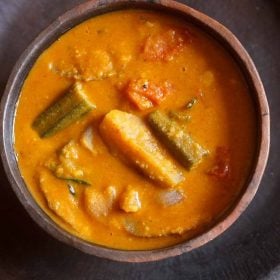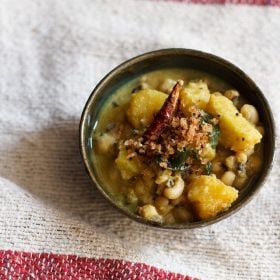
Speaking of the grand sadya meal, which is a specialty during the festival of Onam in Kerala, there’s one dish, without which, it is incomplete. It is the Kalan – a sour-tasting preparation of curd or buttermilk and vegetables like yam and raw banana or plantain. The subtly spiced Kalan Recipe of Kerala cuisine is not just delicious, but very soothing and comforting. A typical ground coconut paste is also added in this dish, which balances the sour flavors from the curd. This recipe is gluten-free too.
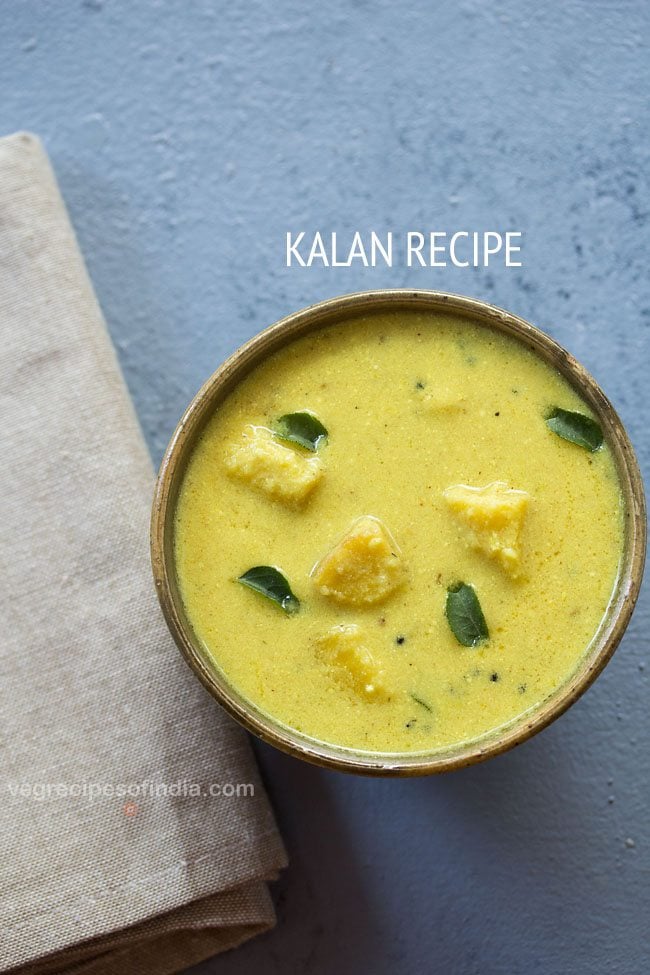
About Kalan
The cuisine of Kerala houses many dishes that are completely vegetarian, some naturally vegan and gluten-free too, yet are supremely delicious and soothing. This Kalan Recipe is one such dish. By the looks of it, you might find a similarity between this and another famous Kerala dish, the Moru Curry or Pulissery.
But both are quite different. Apart from the fact that both these dishes are a yogurt-based gravy, there are elements that differentiate between the two. For instance, in the Kalan, there is also unripe banana (plantain) and/or tubers like elephant foot yam (suran) that are added.
However, the coconut paste that goes in the Kalan Recipe as well as the moru curry are just the same. Fresh coconut is ground with green chilies, cumin seeds and some water into a fine paste and then used for the recipes respectively.
The tempering of Kalan also just has mustard seeds, fenugreek seeds, dried red chilies and curry leaves fried in coconut oil, and then poured over the curry. It is a simple recipe to make and requires not much efforts too. Gets done within half an hour and is gluten-free as well.
About My Recipe
Like I mentioned in the beginning, this Kalan Recipe is from the rich and versatile Kerala Cuisine and is also a part of the elaborate, all-vegetarian Onam sadya. So, you can see that simple dishes like these can also be a part of a celebratory meal.
I make Kalan on many occasions at home. Sometimes, I just add yam and at times, both yam and raw banana. When I prepare this dish, I also prepare a dry sautéed or stir-fried veggie dish like a Thoran to go as an accompaniment with it.
This dish is best served with steamed rice or Kerala matta rice. You can also serve some papaddums and ginger pickle or lemon pickle as a side with it to turn it into a complete, wholesome meal.
Step-by-Step Guide
How to make Kalan
Cook Vegetables
1. Firstly, peel, rinse and chop the elephant foot yam (suran) in cubes or squares. You will need about 1 to 1.25 cups of chopped suran. Take the chopped suran in a pan.
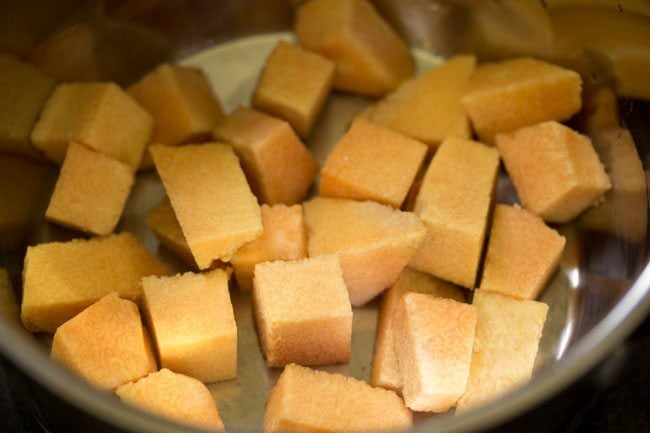
2. Sprinkle ¼ teaspoon turmeric powder, ½ to ¾ teaspoon crushed black pepper and ¼ teaspoon salt.

3. Pour ½ cup water. The water should just about cover the suran cubes.

4. If using plantain (raw unripe banana), then you can add ¾ cup plantain along with ¾ cup of yam. Peel the plantains and chop them before you cook.
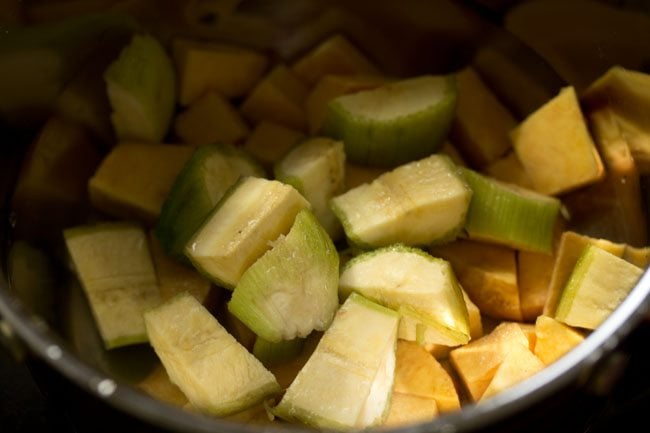
5. Add water just about covering them.

6. Cover the pan with a lid and keep it on a stovetop. Cook on low to medium heat till the veggies turn tender and get cooked.

Make Coconut Paste
7. Meanwhile, take ½ cup tightly packed fresh grated coconut in a grinder jar. Add 2 to 3 chopped green chilies and ½ teaspoon cumin seeds.
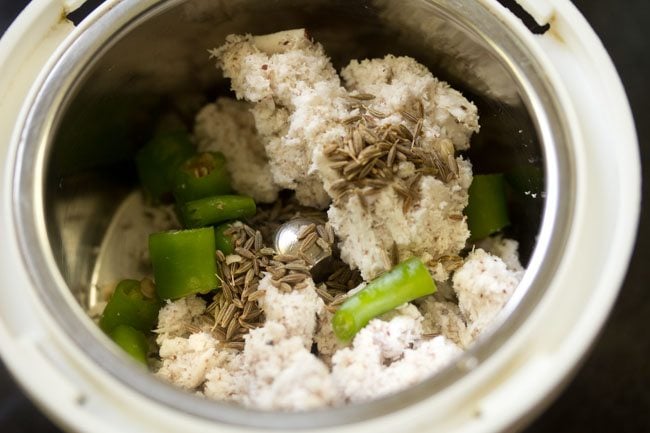
8. Add ¼ to ⅓ cup water and grind to a fine and smooth paste. Set aside.

9. Take 1 cup sour curd (yogurt) in a bowl and beat it with a spoon or wired whisk till smooth. You can also use fresh curd, instead of sour curd.
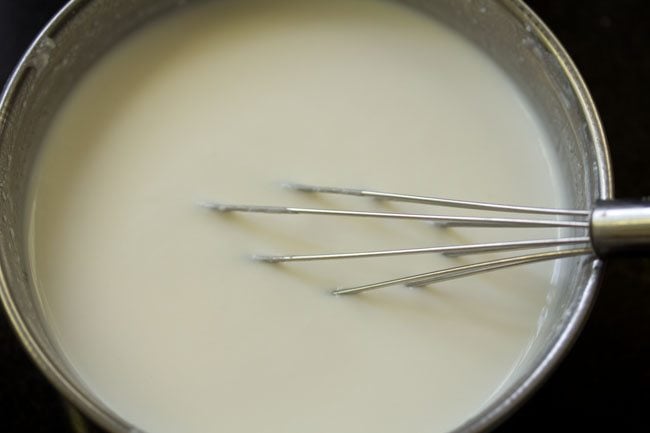
10. While the veggies are getting cooked, check at intervals. In case the water dries up and the veggies are not cooked, then add some more water. Cover and continue to cook.

11. Check if the yam is cooked by cutting it with a knife or passing a knife through a few cubes. The knife should pass easily.
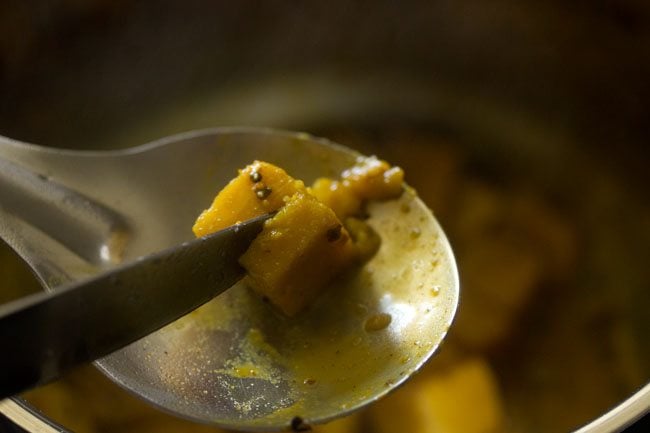
12. If there is water in the pan, then evaporate it without the lid on a low to medium-low heat ensuring you don’t burn the bottom of the pan. There should be no water in the pan, before you proceed to the next step.
Alternatively using a mesh strainer, you could strain the cooked yam or plantains and drain all the liquids.
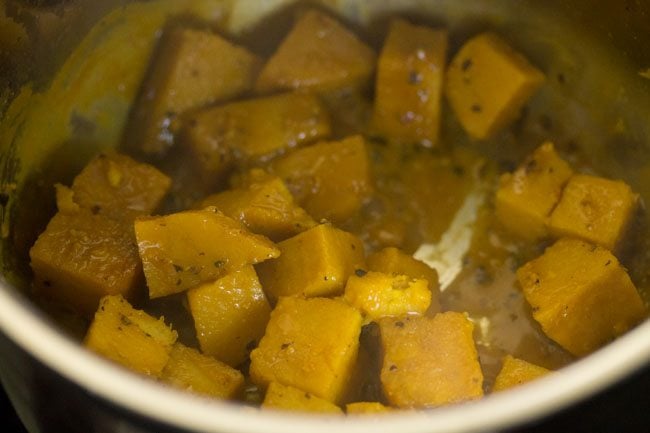
Make Kalan
13. Now, add the prepared coconut paste. Keep the heat to low, while adding coconut paste.
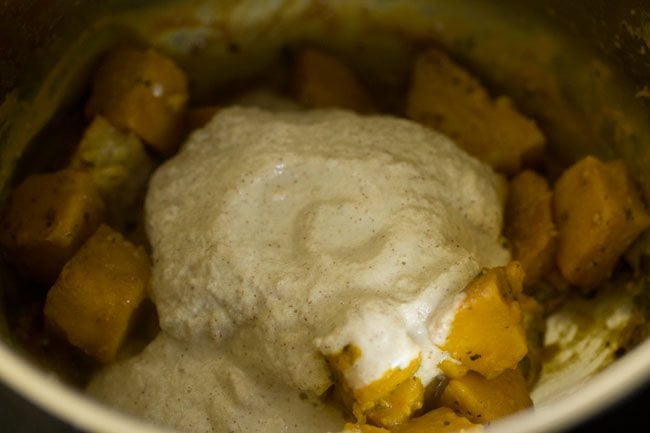
14. Mix very well.
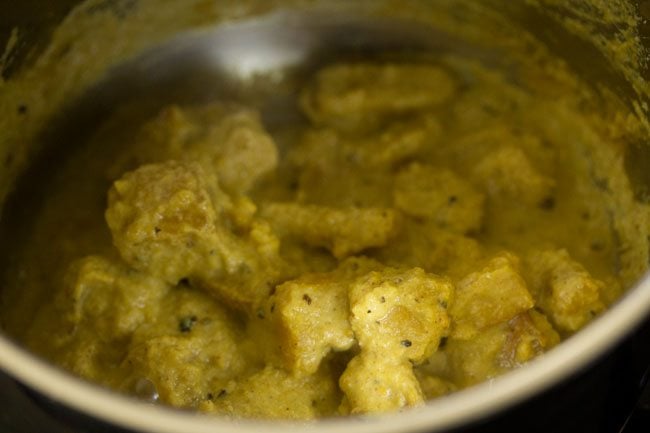
15. Then, add the beaten curd or yogurt.

16. Mix again.
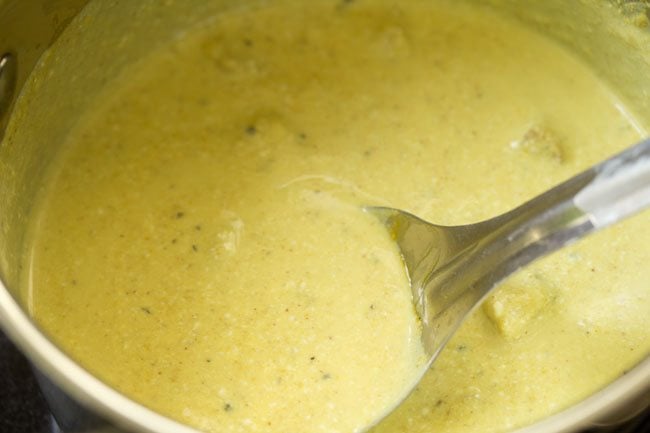
17. If the gravy looks very thick, then you can add ¼ cup water. Mix well.

18. Season with salt. Keep in mind that, while cooking suran (yam), some salt was added.
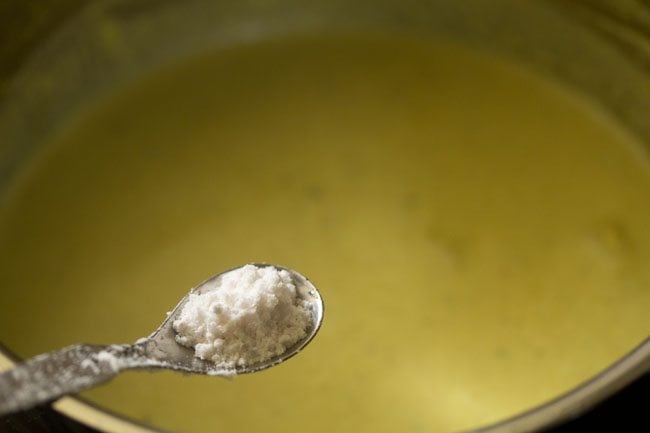
19. Bring the Kalan curry to a gentle boil or simmer on low to medium-low heat. Once the curry comes to a gentle boil, turn off the heat.
Note that on cooling, kalan will thicken more.
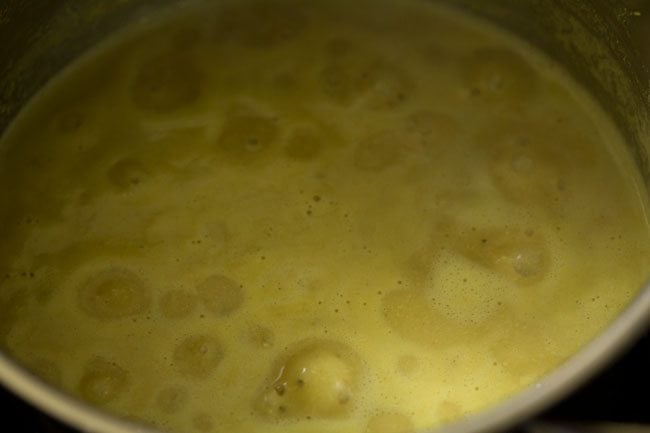
Temper Kalan
20. In a tadka pan or a small frying pan, heat 1 tablespoon coconut oil. Keep the heat to low and add ½ teaspoon mustard seeds.
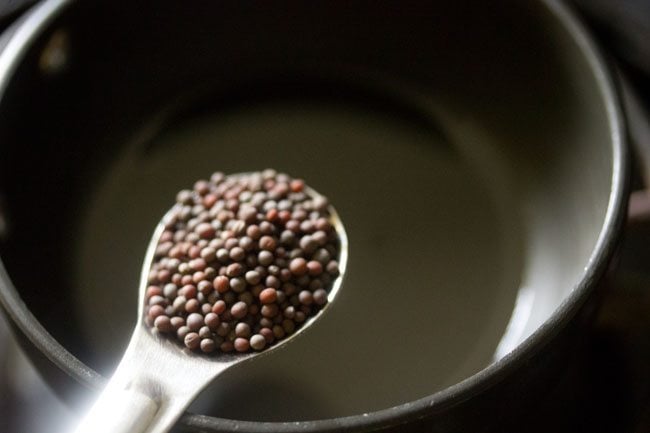
21. Let the mustard seeds crackle.

22. Then, add 1 to 2 dried red chilies (broken and seeds removed) and 10 to 12 curry leaves. Fry till the red chilies change color. Do not burn them.
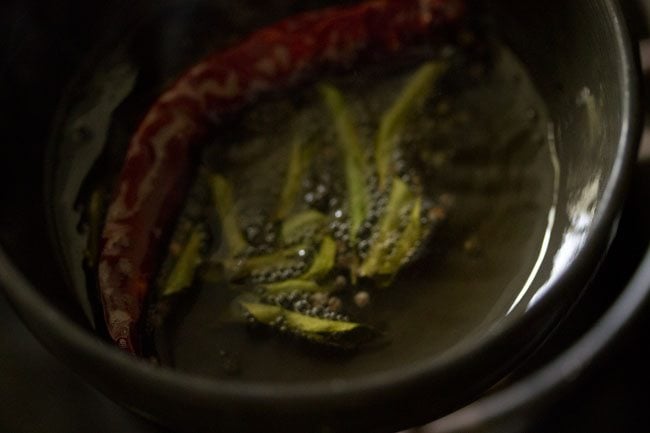
23. Next, add ¼ teaspoon fenugreek seeds (methi seeds), which have been slightly crushed in a mortar-pestle.

24. Mix and turn off the heat.
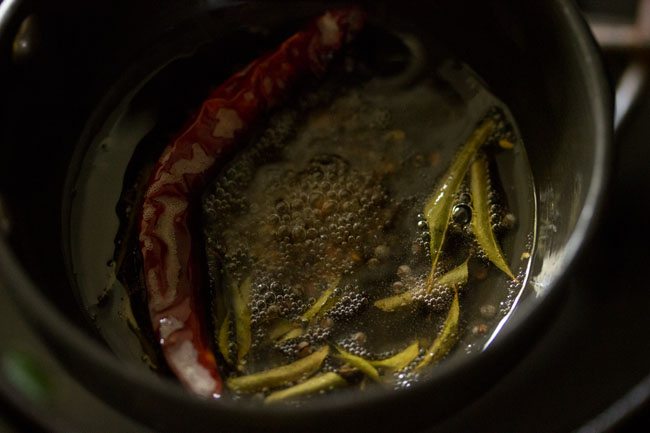
25. Pour the tempering in the Kalan curry. Cover with a lid and let the flavors infuse for 4 to 5 minutes.

26. Mix well and serve Kalan hot with steamed rice.
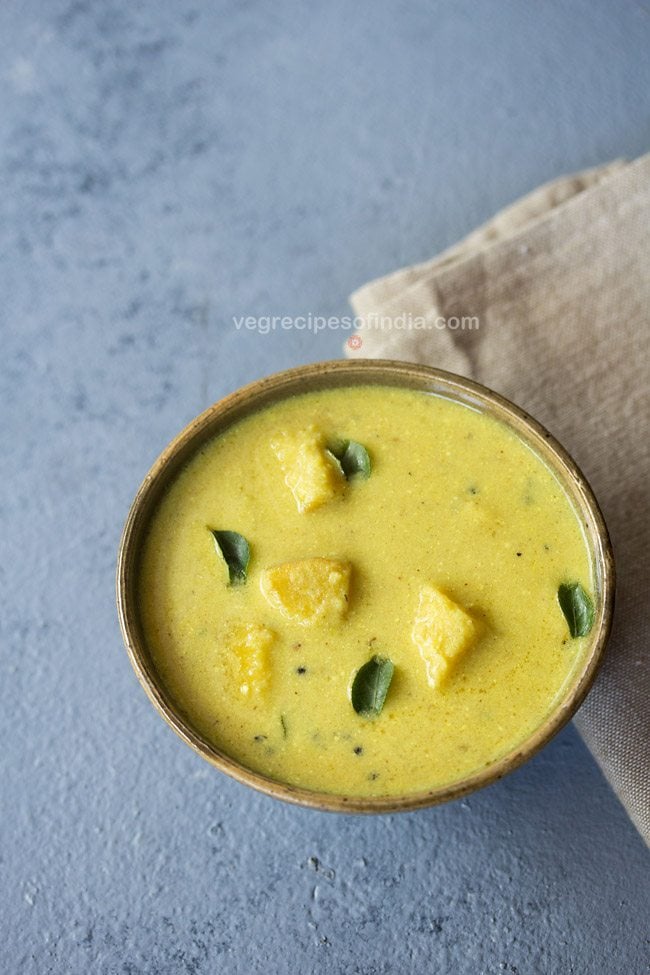
Expert Tips
- Instead of sour curd (sour tasting yogurt), you can also use fresh curd for this recipe. Make sure that the curd is fresh and preferably homemade.
- While the yam is cooking, keep checking once a while. In case the water dries up and the yam pieces are still not cooked, you can add some more water, cover and continue to cook till the yam is well done and tender.
- To check whether the yam pieces are cooked well or no, cut a piece with a knife or pass a knife through a few pieces. It should happen easily.
- Before adding the coconut paste, make sure that there is no water left in the pan in which the veggies are cooked. If there is, then evaporate it without a lid and then add the coconut paste. Alternatively use a mesh strainer and strain the cooked yam or plantains draining all the liquids.
- Both fresh and frozen yam will work in the recipe. Make sure to peel and clean the yam thoroughly in water to get rid of all the dirt and mud particles.
- If using plantains to make Kalan, then ensure that they are not ripe or semi-ripe. The plantains have to peeled and chopped before you cook them. Since plantains darken after chopping, keep them covered in water in bowl before you cook them, if prepping ahead.
- Ensure not to boil the curry vigorously or at a high heat as this may separate or split the curd or yogurt.
- For an authentic taste and flavor, do use coconut oil only.
- If you have very thick gravy, then you can about ¼ cup of water to adjust the consistency. Remember that the curry will thicken more, once it cools. So, adjust the water quantity in the curry accordingly.
More Kerala Recipes To Try!
Vegan Recipes
Kerala Recipes
Curry Recipes
Kerala Recipes
Please be sure to rate the recipe in the recipe card or leave a comment below if you have made it. For more veetarian inspirations, Sign Up for my emails or follow me on Instagram, Youtube, Facebook, Pinterest or Twitter.
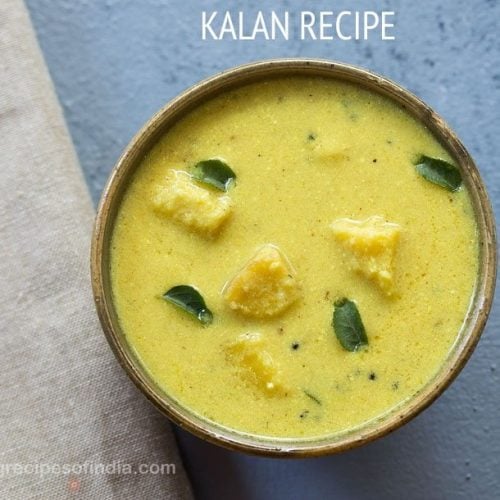
Kalan Recipe | Kerala Kalan Curry
Kalan is a tasty preparation of curd or buttermilk made with vegetables like yam and raw banana or plantain. The subtly spiced Kalan Recipe from the Kerala cuisine is not just delicious, but very soothing and comforting. It is also one of the dishes that is served in the grand feast of the Onam sadya.
Prep Time 10 minutes
Cook Time 20 minutes
Total Time 30 minutes
Prevent your screen from going dark while making the recipe
Cooking veggies
Firstly peel, rinse and then chop the elephant foot yam (suran) in cubes or squares. You will need about 1 to 1.25 cups of chopped suran. Take the chopped suran in a pan.
Sprinkle ¼ teaspoon turmeric powder and ½ to ¾ teaspoon crushed black pepper. Also add ¼ teaspoon salt.
Pour ½ cup water. The water should just about cover the suran cubes.
If using plantain (unripe banana), then you can add ¾ cup of cubed plantains along with ¾ cup of cubed yam.
Add water just about covering them.
Now continuing with step 3 – after adding water in the pan, cover the pan with a lid and keep it on a stove top. Cook on low to medium heat till the suran becomes tender and gets cooked.
Do check at intervals. In case the water dries up and the suran pieces are not cooked, then add some more water. Cover and continue to cook.
Check if the yam is cooked by cutting it with a knife or passing a knife through a few cubes. The knife should pass easily.
Grinding coconut paste and whisking curd
Meanwhile whilst the suran is getting cooked, take ½ cup tightly packed fresh grated coconut in a grinder jar. Add 2 to 3 green chilies (chopped) and ½ teaspoon cumin seeds.
Add ¼ to ⅓ cup water and grind to a smooth paste and keep aside.
Take 1 cup sour curd in a bowl and beat it with a spoon or wired whisk till smooth. You can also use fresh curd instead of sour curd.
Making kalan curry
- Once the yam is cooked and tender, then it is time to add the coconut paste. If there is water in the pan, then evaporate it without the lid. There should be no water in the pan, before you proceed to the next step.Or you could opt to strain the cooked yam using a fine strainer, draining all the liquids.
Now add the ground coconut paste and mix very well. Keep the heat to a low while adding coconut paste.
Then add the beaten curd and mix again.
If the gravy looks very thick, then you can add ¼ cup water. Mix well.
Season with salt. Do keep in mind that while cooking suran, some salt was added.
Bring the curry to a gentle boil or simmer on a low to medium-low heat. Once the curry comes to a gentle boil, then turn off the heat.
Making tempering
In a tadka pan or a small frying pan, heat 1 tablespoon coconut oil. Keep the heat to a low and add ½ teaspoon mustard seeds.
Let the mustard seeds crackle.
Then add 1 to 2 red chilies (seeds removed) and 10 to 12 curry leaves. Fry till the red chilies change color. Do not burn them.
Next add ¼ teaspoon methi seeds which have been slightly crushed in a mortar-pestle.
Mix and turn off the heat.
Pour the tempering mixture in the kalan curry. Cover with a lid and let the flavors mingle for 4 to 5 minutes.
Later mix well and serve Kalan with steamed rice.
- Both fresh and frozen yam work in the recipe.
- Remember to peel and clean the yam thoroughly in water to get rid of all the dirt and mud particles.
- If using plantains, ensure that they are not ripe or semi-ripe.
- Make sure not to boil the curry vigorously as this may separate or split the curd or yogurt.
- For the authentic taste, use coconut oil only.
- The recipe can be easily doubled.
Nutrition Facts
Kalan Recipe | Kerala Kalan Curry
Amount Per Serving
Calories 160 Calories from Fat 81
% Daily Value*
Fat 9g14%
Saturated Fat 7g44%
Cholesterol 8mg3%
Sodium 548mg24%
Potassium 437mg12%
Carbohydrates 17g6%
Fiber 3g13%
Sugar 5g6%
Protein 3g6%
Vitamin A 240IU5%
Vitamin B1 (Thiamine) 1mg67%
Vitamin B2 (Riboflavin) 1mg59%
Vitamin B3 (Niacin) 29mg145%
Vitamin B6 1mg50%
Vitamin B12 1µg17%
Vitamin C 60mg73%
Vitamin D 1µg7%
Vitamin E 1mg7%
Vitamin K 1µg1%
Calcium 91mg9%
Vitamin B9 (Folate) 309µg77%
Iron 1mg6%
Magnesium 20mg5%
Phosphorus 93mg9%
Zinc 1mg7%
* Percent Daily Values are based on a 2000 calorie diet.
This Kalan recipe from the archives first published in August 2017 has been updated and republished on May 2023.

Source link


